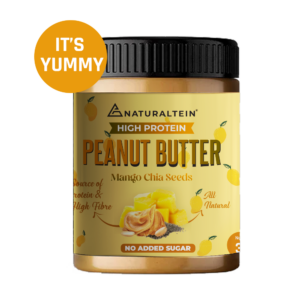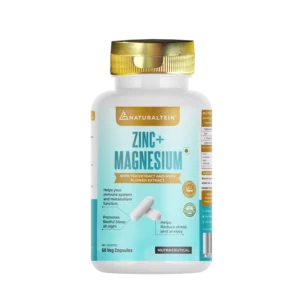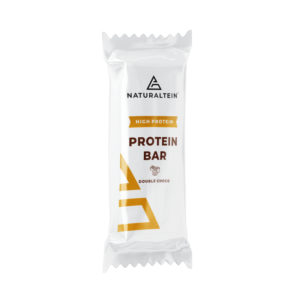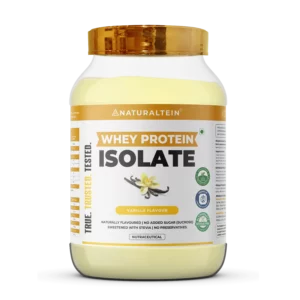If you want to stay healthy, ensure that you have enough protein in your diet. Are you wondering how to increase protein intake? We have the answer right here.
Of course, a healthy, protein-rich diet is a great way to crush your fitness goals and improve your performance. However, you can consider supplementing with whey protein to reach your goals easily. Opt for high-quality whey protein powders from NATURALTEIN – 100% natural and with proven benefits. We offer whey protein in two forms; one is whey protein concentrate, and the other is whey protein isolate.
Now, let us dive right into how to increase protein intake per day.
Importance of having lean protein foods
Protein is a crucial part of your diet. It helps build and repair tissues, including muscle, skin, hair, and nails. Protein also plays an important role in metabolism, the process by which food is used to produce energy(source).
Proteins consist of amino acids- which in turn contain nitrogen atoms. Twenty amino acids can be joined together to form different protein chains, called polypeptides. The body uses these chains to create new proteins or break them down into individual amino acids for use in other chemical processes.
If you want to increase protein intake daily- opt for lean protein. Lean protein sources include vegetarian proteins like beans, pulses, and peas, whey protein powders, fish, and lean cuts meats like chicken breasts or turkey.
Avoid fatty and red meats as they may lead to weight gain and negatively impact your health.
How much protein intake per day?
A high protein diet food can help you build muscle, lose fat, and feel more satisfied. Protein helps you feel full longer and lose weight by curbing your appetite. A daily protein intake for muscle growth prevents muscle wasting when you’re not getting enough protein from your diet.
Your protein level depends on your age, sex, and physical activity level. Moderately active adults require about 0.4 grams of protein per kilogram (2 pounds) of body weight each day or about 10 percent to 35 percent of daily calories from protein sources such as meat, poultry, seafood, eggs, and dairy products.
How to increase healthy protein intake?
1. Add good sources of protein powder to your smoothies or shakes
Many people find it hard to figure out how to increase protein intake. Here is a good answer! Protein powders are great for adding a boost without adding a lot of calories to your diet. It’s easy to find high-quality protein powders at most health food stores, so you don’t have to go bankrupt to get them.
Whey protein isolate is derived from milk, making it a “complete” source of protein. With nine essential amino acids, isolate is an excellent choice for building muscle mass or losing weight. Keep in mind that whey isolate powder has more carbs than other types of whey (and all proteins). So, if you’re looking for something low carb and low calorie, opt for another type of whey instead (or combine with casein).
2. Make a high-protein breakfast with eggs, oatmeal, and nuts
Protein is critical for maintaining muscle mass, so eat plenty of it first thing in the morning. Eggs are a great choice for this meal because they’re quick, easy to prepare and have a good amount of protein per serving. Oatmeal is another good option because it’s high in fiber, which helps you feel fuller longer. Add almonds or walnuts to your oatmeal to add more protein and healthy fats to your breakfast.
3. Top your salad with grilled chicken or salmon
Many people question how to increase protein intake without resorting to unhealthy toppings. Salads can get you more vegetables into your diet, but they can also be loaded with calories from cheese and croutons if you aren’t careful about what goes on top!
Instead of adding these high-calorie toppings, try topping your salad with grilled chicken or salmon. Both are excellent sources of lean protein that will keep you feeling full longer than other most protein foods on this list.
4. Have a bowl of hearty chili for lunch or dinner
This dish has 18 grams of protein per serving, along with lots of vitamins A and C,
folate, iron, and potassium — all nutrients that help keep you healthy and strong. Add some black beans or kidney beans for another 10 grams each (and extra fiber). Beans also contain tryptophan, an amino acid that helps produce serotonin in the brain — a neurotransmitter involved in feelings of well-being.
5. Snack on Greek yogurt or string cheese
Almonds, walnuts, and cashews are all good choices because they’re high in healthy fats that can help keep you full between meals, plus they provide essential nutrients like magnesium, zinc, and vitamin E. You can also try nut butter such as peanut butter or almond butter if you prefer savory snacks over sweet ones. Make sure to watch portion sizes since nuts are high in calories — just 1 ounce (about 23 almonds) delivers 170 calories!
6. Make a veggie and bean burrito for a quick and easy meal
A vegetarian burrito is not only vegan but also gluten-free, dairy-free, egg-free, and nut-free. That makes this dish great for everyone! Add some extra protein to your veggie and bean burrito by adding grilled shrimp or tofu. This makes that you get adequate protein into your diet daily.
7. Add some extra protein to your pasta dish with grilled shrimp or tofu
If you want to level up your pasta dinner, try adding some grilled shrimp or tofu to the mix! Grilling these proteins adds an extra layer of flavor to help make your meal more interesting (and nutritious). You can also use vegetables like bell peppers and onions to add flavor without making things too complicated!
8. Enjoy a glass of milk or a protein shake after your workout
Milk contains both carbohydrates for energy and protein for muscle recovery after exercise. A 1-cup serving of milk has about 8 grams of carbs and 9 grams of protein (the same as an egg). These numbers vary depending on the brand, so check the label before choosing one with more carbohydrates than you need.
A protein shake comes loaded with proteins and helps your body recover faster from workouts. Have they after your activities for best results. They will also help you build lean muscle mass. Trust NATURALTEIN for the best quality protein powders to make your shakes tasty and healthy.
9. Make peanut butter and jelly sandwiches on whole-wheat bread
Peanut butter is another good source of protein, especially for vegetarians who don’t get enough from meat sources like chicken or fish. A study published in the American Journal of Clinical Nutrition found that adding peanut butter to sandwiches instead of refined grains such as white bread resulted in higher energy expenditure and fat oxidation for up to 16 hours after eating!
10. Try one of the many high-protein bars or snacks on the market
Protein bars come in various flavors, including chocolate chip cookie dough, peanut butter and jelly, and cinnamon roll. Each bar contains about 10 grams of protein and a few calories, making them an easy way to increase your protein intake daily without having to cook anything at home or order an extra dish at dinner.
However, stay away from off-the-counter bars that come loaded with sugar or preservatives.
Benefits of lean protein
Lean protein is full of nutrients and can be an important part of a healthy diet. It is not only good for you, but it’s also delicious. Lean protein can help provide energy, fight hunger, and help you feel fuller longer. Daily protein intake for weight loss lead to the building of muscle mass.
In addition to these benefits, lean protein may help protect your heart health by lowering blood cholesterol levels and reducing heart disease risk factors.
High protein low calorie foods
Lean meats, fish, and poultry are the best high protein, low calorie diet. The following are high in protein and low calorie protein foods(source):
Chicken breast (3 ounces) – 59 calories, 24 grams of protein
Salmon (3 ounces) – 172 calories, 22 grams of protein
Whitefish (3 ounces) – 99 calories, 22 grams of protein
Eggs (1 significant) – 80 calories, 6 grams of protein
Tuna in water (3 ounces) – 60 calories, 15 grams of protein
150g of daily protein intake to build muscle is enough.
The short answer is yes, 150g is enough to build muscle.
The long answer is that 150g of protein doesn’t make a huge difference in your muscle-building ability, but it will not hurt you either.
The amount of protein you need depends on your body weight, activity level, and dietary preferences. The RDA for protein for adults over 18 years old is 0.8 grams per kilogram (0.36 grams per pound).
If you are trying to build muscle or lose fat, you will want to consume more than this amount because your body needs extra amino acids to build new tissue. However, if you’re trying to maintain your weight or stay healthy while eating fewer calories than normal, you don’t need more than 0.8 grams per kilogram (0.36 grams per pound) per day.
Conclusion
There are many ways to increase your protein intake. You can eat more protein foods like meat, fish, eggs, and dairy. And can also add protein powders or supplements to your diet. Choose our protein powders to increase your protein intake for muscle gain and weight loss. NATURALTEIN offers a wide range of products like vegan protein powder, pre workout supplements, creatine monohydrate powder, etc. Visit our website to know more about our products.
FAQs regarding increase protein intake
The answer to this question depends on the type of food you are comparing. For example, whey protein powder has more protein than chicken breast, but chicken breast contains much more protein than rice. Let’s look at some examples.
1) Rice: 2 cups of cooked white rice contains 5 grams of protein. In comparison, 1 cup of milk contains 8 grams of protein, and 1 cup of spinach contains 4 grams.
2) Spinach: 1 cup of raw spinach contains 3 grams of protein, and 1 cup of cooked lentils has 16 grams of protein.
3) Lentils: 1 cup (cooked) of lentils contains 17 grams of protein, and 1 cup (cooked) quinoa contains 8 grams of protein.
4) Quinoa: 1 cup (cooked) quinoa contains 18 grams of protein, and 1 cup of milk contains 8 grams of protein.
Talk to your doctor to see if you can go for whey protein supplementation. NATURALTEIN has a range of clean protein products that are trusted by health enthusiasts and athletes worldwide. Check out our product range to make the right choice.
The average recommended daily protein intake is 0.8 grams per kilogram of body weight for adults. So for a person who weighs 150 pounds, the recommendation would be about 50 grams of protein per day. For someone who weighs 200 pounds, it would be about 60 grams of protein per day.
If you’re eating a high-protein diet, aim for around 1 gram per kilogram of body weight. But if that’s too much for you to digest, start with half that amount and work up from there.
Protein helps build and repair body tissues, including muscles and bones. It also provides the amino acids needed for making hormones and enzymes involved in digestion and metabolism.
Protein is important during childhood for growth and development. It is also helpful to boost immune system throughout life.
A lack of protein may lead to weight loss or failure to gain weight normally (failure to thrive). A diet high in saturated fats can reduce your appetite for best natural protein foods, so ensure you get enough calories from other sources if you follow a low-fat diet.
We all know that too much of anything is bad. But what about protein? Can you eat too much protein?
You might be surprised to hear that the answer is yes, you can eat too much protein. The Recommended Dietary Allowance (RDA) for protein is 0.8 g/kg body weight per day, roughly equivalent to 10% of your daily calorie intake. This equates to approximately 56 g of protein per day for a woman who weighs 130 pounds (59 kg).
This recommendation applies regardless of age or sex.
The RDA for children ranges from 0.7 to 1 g/kg body weight per day, depending on age and growth rate. For example, an 11-year-old boy weighing 65 kg needs about 102 g of protein daily (0.68 x 65 kg x 1).
However, many people consume significantly more than this amount in their diet every
a day without any problems – even if they are athletes or fitness enthusiasts who exercise regularly and get plenty of calories!
The answer to this question is yes. Eating protein at every meal is important for several reasons. Protein is the building block of muscle and other tissues in your body. It helps maintain muscle mass as you age, which can help prevent age-related muscle loss and weakness.
Protein also helps you feel full longer, so it’s good for weight management.
Since lean muscle burns more calories than fat, maintaining a lean body mass is crucial for weight management. Along with that, you’ll get stronger and feel more energized.
It helps you maintain bone mass and prevent bone loss caused by aging or dieting (which can lead to osteoporosis).





